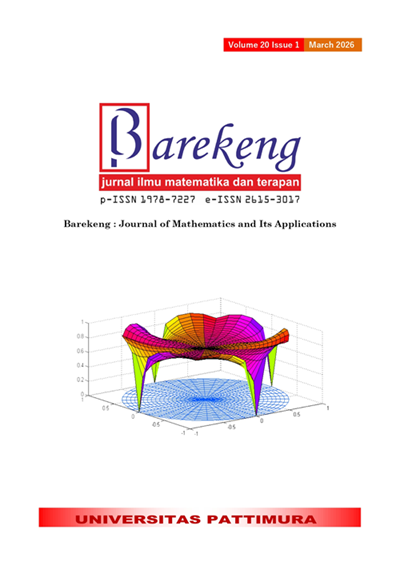ENHANCING VOLATILITY MODELING WITH LOG-LINEAR REALIZED GARCH-CJ: EVIDENCE FROM THE TOKYO STOCK PRICE INDEX
Abstract
This study compares the Log-linear Realized GARCH (LRG) and its extension with Continuous and Jump components (LRG-CJ) in modeling the volatility of financial assets, using daily data from the Tokyo Stock Price Index (TOPIX) over 2004–2011. The urgency arises from the need for more accurate volatility models during turbulent periods such as the 2008 Global Financial Crisis and the 2011 Great East Japan Earthquake, where markets exhibit both smooth fluctuations and abrupt jumps. Methodologically, the LRG-CJ framework introduces a novel integration of continuous and jump decomposition into the LRG structure, offering an applied innovation to high-frequency volatility modeling. Realized Volatility (RV) was calculated from 1-, 5-, and 10-minute intraday data and decomposed into continuous and jump components. Parameter estimation employed the Adaptive Random Walk Metropolis (ARWM) within a Markov Chain Monte Carlo algorithm, while model performance was assessed using multiple information criteria and out-of-sample forecast evaluations. The empirical results reveal that incorporating continuous and jump components improves volatility modeling accuracy, forecasting, and Value-at-Risk estimation. However, these benefits are frequency-dependent: the LRG-CJ model shows superior in-sample fit for 1-minute RV but provides the strongest out-of-sample forecasting and risk prediction at lower frequencies (5- and 10-minute intervals). This highlights that while jumps are best identified at ultra-high frequencies, their predictive value is most effectively captured in slightly aggregated data. The originality of this study lies in being the first empirical application of LRG-CJ, demonstrating how continuous–jump decomposition interacts with the dual-equation structure of LRG, which has not been examined in TGARCH or APARCH contexts. Limitations include sensitivity to microstructure noise in very high-frequency data and computational challenges in parameter convergence. Overall, the findings underscore the novelty and practical importance of the LRG-CJ framework for risk management, offering actionable guidance for aligning volatility models with data frequency
Downloads
References
L. Wang, F. Ma, J. Liu, and L. Yang, “FORECASTING STOCK PRICE VOLATILITY: NEW EVIDENCE FROM THE GARCH-MIDAS MODEL,” Int J Forecast, vol. 36, no. 2, pp. 684–694, 2020, doi: https://doi.org/10.1016/j.ijforecast.2019.08.005.
T. Bollerslev, “THE STORY OF GARCH: A PERSONAL ODYSSEY,” J Econom, vol. 234, pp. 96–100, 2023, doi: https://doi.org/10.1016/j.jeconom.2023.01.015.
D. B. Nugroho, B. A. A. Wicaksono, and L. Larwuy, “GARCH-X(1,1) MODEL ALLOWING A NON-LINEAR FUNCTION OF THE VARIANCE TO FOLLOW AN AR(1) PROCESS,” Commun Stat Appl Methods, vol. 30, no. 2, pp. 163–178, 2023, doi: https://doi.org/10.29220/CSAM.2023.30.2.163.
H. Zhang and Q. Lan, “GARCH-TYPE MODEL WITH CONTINUOUS AND JUMP VARIATION FOR STOCK VOLATILITY AND ITS EMPIRICAL STUDY IN CHINA,” Math Probl Eng, vol. 2014, 2014, doi: https://doi.org/10.1155/2014/386721.
V. Mahajan, S. Thakan, and A. Malik, “MODELING AND FORECASTING THE VOLATILITY OF NIFTY 50 USING GARCH AND RNN MODELS,” Econ, vol. 10, no. 5, pp. 1–20, 2022, doi: https://doi.org/10.3390/economies10050102.
H. Yildirim and F. V. Bekun, “PREDICTING VOLATILITY OF BITCOIN RETURNS WITH ARCH, GARCH AND EGARCH MODELS,” Futur Bus J, vol. 9, no. 1, pp. 1–8, 2023, doi: https://doi.org/10.1186/s43093-023-00255-8.
A. Lama, G. K. Jha, R. K. Paul, and B. Gurung, “MODELLING AND FORECASTING OF PRICE VOLATILITY: AN APPLICATION OF GARCH AND EGARCH MODELS,” Agric Econ Res Rev, vol. 28, no. 1, pp. 73–82, 2015, doi: https://doi.org/10.5958/0974-0279.2015.00005.1.
N. T. Hung, “VOLATILITY BEHAVIOUR OF THE FOREIGN EXCHANGE RATE AND TRANSMISSION AMONG CENTRAL AND EASTERN EUROPEAN COUNTRIES: EVIDENCE FROM THE EGARCH MODEL,” Glob Bus Rev, vol. 22, no. 1, pp. 36–56, 2021, doi: https://doi.org/10.1177/0972150918811713.
P. R. Hansen and Z. Huang, “EXPONENTIAL GARCH MODELING WITH REALIZED MEASURES OF VOLATILITY,” J Bus Econ Stat, vol. 34, no. 2, pp. 269–287, 2016, doi: https://doi.org/10.1080/07350015.2015.1038543.
D. B. Nugroho, J. Wijaya, and A. Setiawan, “MODELING OF RETURNS VOLATILITY THROUGH EGARCH MODEL USING HIGH-FREQUENCY DATA,” J Appl Probab Stat, vol. 18, no. 2, pp. 55–73, 2023.
A.-C. Petrica, S. Stancu, and V. Ghițulescu, “EGARCH VERSUS PARCH APPROACH IN MODELING DEVELOPED AND UNDERDEVELOPED STOCK MARKETS,” in Proc Basiq Int Conf New Trends Sustain Bus Consum, R. Pamfilie, V. Dinu, L. Tachiciu, D. Plesea, and C. Vasiliu, Eds., Graz: Editura ASE, May 2017, pp. 513–521.
Y. Zhuo and T. Morimoto, “A HYBRID MODEL FOR FORECASTING REALIZED VOLATILITY BASED ON HETEROGENEOUS AUTOREGRESSIVE MODEL AND SUPPORT VECTOR REGRESSION,” Risks, vol. 12, no. 1, 2024, doi: https://doi.org/10.3390/risks12010012.
D. B. Nugroho, N. I. M. Urosidin, and H. A. Parhusip, “COMPARISON OF APARCH-TYPE MODELS: DOES THE CONTINUOUS AND JUMP COMPONENTS OF REALIZED VOLATILITY IMPROVE THE FITTING?,” BAREKENG J Math Appl, vol. 18, no. 1, pp. 0085–0094, 2024, doi: https://doi.org/10.30598/barekengvol18iss1pp0085-0094.
S. E. F. Spencer, “ACCELERATING ADAPTATION IN THE ADAPTIVE METROPOLIS-HASTINGS RANDOM WALK ALGORITHM,” Aust. N. Z. J. Stat, vol. 63, no. 3, pp. 468–484, 2021, doi: https://doi.org/10.1111/anzs.12344.
S. Foster and D. Leveau, “IS INTRADAY DATA THE KEY TO BETTER VOLATILITY ESTIMATION?,” SSRN Electron J, 2022, doi: https://doi.org/10.2139/ssrn.4438104
D. S. Kambouroudis, D. G. McMillan, and K. Tsakou, “FORECASTING REALIZED VOLATILITY: THE ROLE OF IMPLIED VOLATILITY, LEVERAGE EFFECT, OVERNIGHT RETURNS, AND VOLATILITY OF REALIZED VOLATILITY,” J Futur Mark, vol. 41, no. 10, pp. 1618–1639, 2021, doi: https://doi.org/10.1002/fut.22241.
G. Romeo, ELEMENTS OF NUMERICAL MATHEMATICAL ECONOMICS WITH EXCEL. Elsevier Academic Press, 2020.
H. Liu, Y. Li, Y. Li, C. Chen, and Z. Duan, SMART METRO STATION SYSTEM. Elsevier, 2022.
H. Chen, J. Zhang, Y. Tao, and F. Tan, “ASYMMETRIC GARCH TYPE MODELS FOR ASYMMETRIC VOLATILITY CHARACTERISTICS ANALYSIS AND WIND POWER FORECASTING,” Prot Control Mod Power Syst, vol. 4, no. 1, pp. 1–11, 2019, doi: https://doi.org/10.1186/s41601-019-0146-0.
E. Villar-Rubio, M. D. Huete-Morales, and F. Galán-Valdivieso, “USING EGARCH MODELS TO PREDICT VOLATILITY IN UNCONSOLIDATED FINANCIAL MARKETS: THE CASE OF EUROPEAN CARBON ALLOWANCES,” J Environ Stud Sci, vol. 13, no. 3, pp. 500–509, 2023, doi: https://doi.org/10.1007/s13412-023-00838-5.
H. Zhang and Q. Lan, “GARCH-TYPE MODEL WITH CONTINUOUS AND JUMP VARIATION FOR STOCK VOLATILITY AND ITS EMPIRICAL STUDY IN CHINA,” Math Probl Eng, vol. 2014, 2014, doi: https://doi.org/10.1155/2014/386721.
D. van Ravenzwaaij, P. Cassey, and S. D. Brown, “A SIMPLE INTRODUCTION TO MARKOV CHAIN MONTE–CARLO SAMPLING,” Psychon Bull Rev, vol. 25, no. 1, pp. 143–154, Feb. 2018, doi: https://doi.org/10.3758/s13423-016-1015-8.
J. M. Pawlowski and J. M. Urban, “REDUCING AUTOCORRELATION TIMES IN LATTICE SIMULATIONS WITH GENERATIVE ADVERSARIAL NETWORKS,” Mach Learn Sci Technol, vol. 1, no. 4, p. 045011, 2020, doi: https://doi.org/10.1088/2632-2153/abae73.
S. Zitzmann, S. Weirich, and M. Hecht, “USING THE EFFECTIVE SAMPLE SIZE AS THE STOPPING CRITERION IN MARKOV CHAIN MONTE CARLO WITH THE BAYES MODULE IN MPLUS,” Psych, vol. 3, pp. 336–347, 2021, doi: https://doi.org/10.3390/psych3030025.
J. J. Dziak, D. L. Coffman, S. T. Lanza, R. Li, and L. S. Jermiin, “SENSITIVITY AND SPECIFICITY OF INFORMATION CRITERIA,” Brief Bioinform, vol. 21, no. 2, pp. 553–565, 2020, doi: https://doi.org/10.1093/bib/bbz016
D. Buncic and K. I. M. Gisler, “THE ROLE OF JUMPS AND LEVERAGE IN FORECASTING VOLATILITY IN INTERNATIONAL EQUITY MARKETS,” J Int Money Finance, vol. 79, pp. 1–19, 2017, doi: https://doi.org/10.1016/j.jimonfin.2017.09.001
M. Asai, R. Gupta, and M. McAleer, “THE IMPACT OF JUMPS AND LEVERAGE IN FORECASTING THE CO-VOLATILITY OF OIL AND GOLD FUTURES,” Energies (Basel), vol. 12, no. 17, p. 3379, 2019, doi: https://doi.org/10.3390/en12173379.
C. Zhang, Z. Liu, and Q. Liu, “JUMPS AT ULTRA-HIGH FREQUENCY: EVIDENCE FROM THE CHINESE STOCK MARKET,” Pac-Basin Financ J, vol. 68, p. 101420, Sep. 2021, doi: https://doi.org/10.1016/j.pacfin.2020.101420.
R. Hizmeri, M. Izzeldin, and G. Urga, “IDENTIFYING THE UNDERLYING COMPONENTS OF HIGH-FREQUENCY DATA: PURE VS JUMP DIFFUSION PROCESSES,” J Empir Finance, vol. 81, p. 101594, 2025, doi: https://doi.org/10.1016/j.jempfin.2025.101594.
T. Bollerslev, B. Hood, J. Huss, and L. H. Pedersen, “RISK EVERYWHERE: MODELING AND MANAGING VOLATILITY,” Rev Financ Stud, vol. 31, no. 7, pp. 2729–2773, 2018, doi: https://doi.org/10.1093/rfs/hhy041
A. Eriksson, D. P. A. Preve, and J. Yu, “FORECASTING REALIZED VOLATILITY USING A NONNEGATIVE SEMIPARAMETRIC MODEL,” J Risk Financ Manag, vol. 12, no. 3, pp. 1–23, 2019, doi: ttps://doi.org/10.3390/jrfm12030139.
D. Chicco, M. J. Warrens, and G. Jurman, “THE COEFFICIENT OF DETERMINATION R-SQUARED IS MORE INFORMATIVE THAN SMAPE, MAE, MAPE, MSE AND RMSE IN REGRESSION ANALYSIS EVALUATION,” PeerJ Comput Sci, vol. 7, pp. 1–24, 2021, doi: https://doi.org/10.7717/peerj-cs.623/supp-1.
L. Y. Liu, A. J. Patton, and K. Sheppard, “DOES ANYTHING BEAT 5-MINUTE RV? A COMPARISON OF REALIZED MEASURES ACROSS MULTIPLE ASSET CLASSES,” J Econom, vol. 187, no. 1, pp. 293–311, 2015, doi: https://doi.org/10.1016/j.jeconom.2015.02.008.
Z. D. Khoo, K. H. Ng, Y. B. Koh, and K. H. Ng, “FORECASTING VOLATILITY OF STOCK INDICES: IMPROVED GARCH-TYPE MODELS THROUGH COMBINED WEIGHTED VOLATILITY MEASURE AND WEIGHTED VOLATILITY INDICATORS,” N Am J Econ Financ, vol. 71, p. 102112, Mar. 2024, doi: https://doi.org/10.1016/j.najef.2024.102112.
T. Trimono and D. A. Maruddani, “COMPARISON BETWEEN ALUE AT RISK AND ADJUSTED EXPECTED SHORTFALL: A NUMERICAL ANALYSIS,” BAREKENG J Math Appl, vol. 17, no. 3, pp. 1347–1358, 2023, doi: https://doi.org/10.30598/barekengvol17iss3pp1347-1358.
S. Zamani, A. Chaghazardi, and H. Arian, “PATHWISE GRID VALUATION OF FIXED-INCOME PORTFOLIOS WITH APPLICATIONS TO RISK MANAGEMENT,” Heliyon, vol. 8, no. 7, p. e09880, 2022, doi: https://doi.org/10.1016/j.heliyon.2022.e09880.
Copyright (c) 2025 Didit Budi Nugroho, Zefania Sasongko Putri, Benita Dwitya Putri, Anggita Mega Kusumawati, Jordi Enal Ambat, Harfely Leipary, Bambang Susanto

This work is licensed under a Creative Commons Attribution-ShareAlike 4.0 International License.
Authors who publish with this Journal agree to the following terms:
- Author retain copyright and grant the journal right of first publication with the work simultaneously licensed under a creative commons attribution license that allow others to share the work within an acknowledgement of the work’s authorship and initial publication of this journal.
- Authors are able to enter into separate, additional contractual arrangement for the non-exclusive distribution of the journal’s published version of the work (e.g. acknowledgement of its initial publication in this journal).
- Authors are permitted and encouraged to post their work online (e.g. in institutional repositories or on their websites) prior to and during the submission process, as it can lead to productive exchanges, as well as earlier and greater citation of published works.






1.gif)



